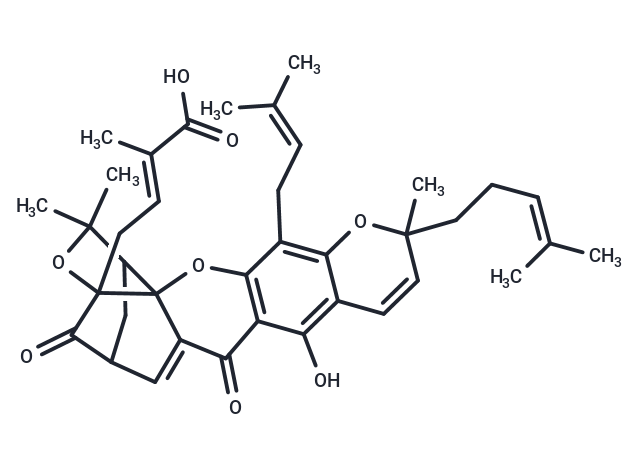Shopping Cart
- Remove All
 Your shopping cart is currently empty
Your shopping cart is currently empty

Gambogic Acid (Guttic Acid) ( EC50=0.78-1.64 uM) activates caspases. Gambogic Acid competitively suppresses Bcl-XL, Bcl-2, Bcl-W, Bcl-B, Bfl-1 and Mcl-1. The IC50s of Gambogic Acid for Bcl-XL, Bcl-2, Bcl-W, Bcl-B, Bfl-1 and Mcl-1 are 1.47, 1.21, 2.02, 0.66, 1.06 and 0.79 uM, respectively.

| Pack Size | Price | Availability | Quantity |
|---|---|---|---|
| 2 mg | $33 | In Stock | |
| 5 mg | $50 | In Stock | |
| 10 mg | $70 | In Stock | |
| 25 mg | $113 | In Stock | |
| 50 mg | $163 | In Stock | |
| 100 mg | $239 | In Stock | |
| 500 mg | $589 | In Stock | |
| 1 mL x 10 mM (in DMSO) | $80 | In Stock |
| Description | Gambogic Acid (Guttic Acid) ( EC50=0.78-1.64 uM) activates caspases. Gambogic Acid competitively suppresses Bcl-XL, Bcl-2, Bcl-W, Bcl-B, Bfl-1 and Mcl-1. The IC50s of Gambogic Acid for Bcl-XL, Bcl-2, Bcl-W, Bcl-B, Bfl-1 and Mcl-1 are 1.47, 1.21, 2.02, 0.66, 1.06 and 0.79 uM, respectively. |
| Targets&IC50 | BCL-B:0.66μM, BCL-W:2.02μM, BCL-XL:1.47μM, BCL2:1.21μM, Bfl-1:1.06μM, MCL1:0.79 μM |
| In vitro | Gambogic Acid is a caged xanthone that is derived from Garcinia hanburyi and functions as a strong apoptotic inducer in many types of cancer cells by inhibiting human Bcl-2 family proteins and activating caspases. Gambogic Acid also blocks Kir2.1 channels with EC50 of ≤ 100 nM.[1] [2] [3] Gambogic Acid significantly inhibits human umbilical vein endothelial cell (HUVEC) proliferation, migration, invasion, tube formation, and micro-vessel growth at nM concentration. [4] |
| In vivo | Gambogic Acid effectively inhibits tumor angiogenesis and suppressed tumor growth with low side effects using metronomic chemotherapy with Gambogic Acid. [4] Gambogic Acid has multiple functional effects including the induction of apoptosis, the inhibition of proliferation and the prevention of cancer metastasis and tumor angiogenesis. [5] In both animal tumor models and Clinicalal trials, Gambogic Acid efficiently inhibits tumor growth with minimal side effects, with little toxicity on immune and hemopoietic systems. Gambogic Acid can produce tissue-specific proteasome inhibition and tumor-specific toxicity. [6] LD50: Mice 45 mg/kg (i.p.). [7] |
| Kinase Assay | The fluorescence polarization reactions are performed. For Kidetermination, duplicate 200 μL reactions are set up at eight different ATP concentrations from 200 μM (2-fold serial dilutions) in the presence of either DMSO or R406 at 125, 62.5, 31.25, 15.5, or 7.8 nM. At different time points, 20 μL of each reaction is removed and quenched to stop the reaction. For each concentration of R406, the rate of reaction at each concentration of ATP is determined and plotted against the ATP concentration to determine the apparent Km and Vmax (maximal rate). Finally the apparent Km (or apparent Km/Vmax) is plotted against the inhibitor concentration to determine the Ki. All data analysis is performed using Prism and Prism enzyme kinetics programs[1] |
| Alias | Guttic Acid, Guttatic Acid, Beta-Guttiferrin |
| Molecular Weight | 628.75 |
| Formula | C38H44O8 |
| Cas No. | 2752-65-0 |
| Smiles | CC(C)=CCCC1(C)OC2=C(CC=C(C)C)C3=C(C(O)=C2C=C1)C(=O)C1=CC2CC4C(C)(C)OC(C\C=C(/C)C(O)=O)(C2=O)C14O3 |
| Relative Density. | 1.29 g/cm3 |
| Storage | store at low temperature,keep away from direct sunlight | Powder: -20°C for 3 years | In solvent: -80°C for 1 year | Shipping with blue ice. | ||||||||||||||||||||||||||||||||||||||||
| Solubility Information | H2O: Insoluble DMSO: 47.2 mg/mL (75.07 mM), Sonication is recommended. Ethanol: 62.9 mg/mL (100.04 mM), Sonication is recommended. | ||||||||||||||||||||||||||||||||||||||||
Solution Preparation Table | |||||||||||||||||||||||||||||||||||||||||
DMSO/Ethanol
Ethanol
| |||||||||||||||||||||||||||||||||||||||||

Copyright © 2015-2025 TargetMol Chemicals Inc. All Rights Reserved.